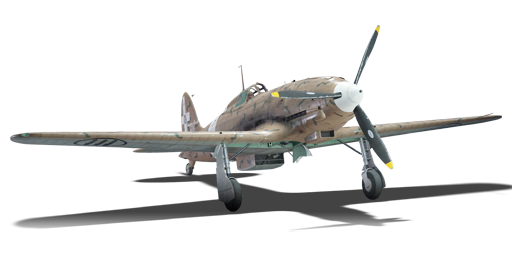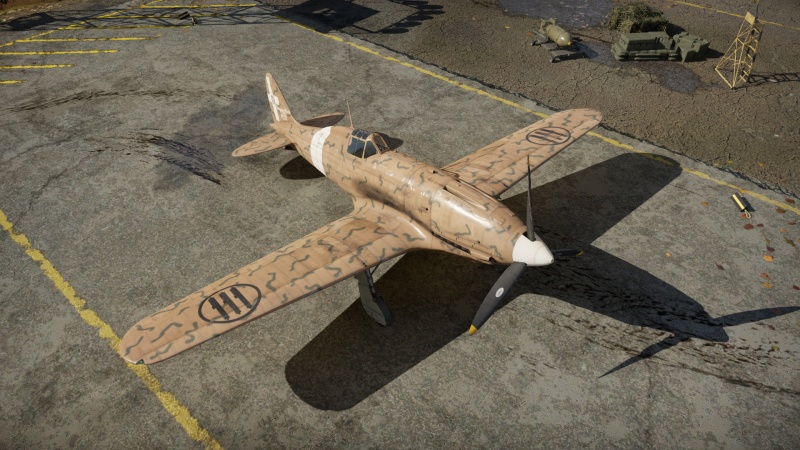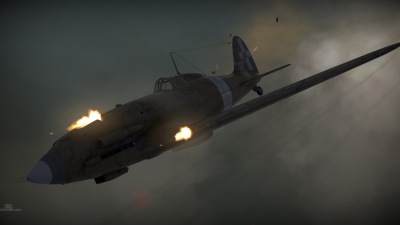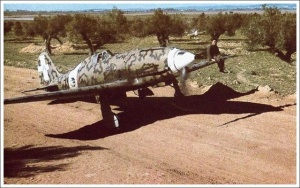Difference between revisions of "C. 202"
(→Description: New Description Project) (Tag: Visual edit) |
(→Description) |
||
| Line 10: | Line 10: | ||
== Description == | == Description == | ||
| − | <!-- ''In the description, the first part should be about the history of and the creation and combat usage of the aircraft, as well as its key features. In the second part, tell the reader about the aircraft in the game. Insert a screenshot of the vehicle, so that if the novice player does not remember the vehicle by name, he will immediately understand what kind of vehicle the article is talking about.'' -->The ''' | + | <!-- ''In the description, the first part should be about the history of and the creation and combat usage of the aircraft, as well as its key features. In the second part, tell the reader about the aircraft in the game. Insert a screenshot of the vehicle, so that if the novice player does not remember the vehicle by name, he will immediately understand what kind of vehicle the article is talking about.'' --> |
| + | The '''C.202 "Folgore"''' (''Lightning'') was the successor to the Macchi [[C. 200 (Family)|C.200]]. Developed by Italian engineer Mario Castoldi, the aircraft proved very effective against its contemporaries after its introduction in 1941. It was mainly used in the North Africa campaign and remained there until 1943, when Italian forces were diverted to Sicily to hold against the Allied invasion. The aircraft was also deployed in limited numbers against the Soviet Union. It was succeeded by the Macchi C.205, with a total of 1,150 manufactured. | ||
| − | + | The '''C.202''' was introduced in [[Update 1.69 "Regia Aeronautica"]], though an [[C. 202 (Germany)|identical version]] existed in the German tech tree prior to the update. It is a fighter dedicated to air superiority and air-to-air combat due to its lack of ground ordnance. The aircraft features a solid combination of good speed, very good rate of climb, and good roll speed. One downside, however, is the low damage output. Since it lacks cannons, it relies on 12.7 mm and 7.7 mm guns that, while sufficient for dogfighting even though they require long bursts to take down targets, are not effective against bombers. Overall, this aircraft is a dogfighter that relies on its performance rather than its armament to defeat enemies. | |
[[File:FighterImage_C202.jpg|thumbnail|right|''Over the deserts of Africa'']] | [[File:FighterImage_C202.jpg|thumbnail|right|''Over the deserts of Africa'']] | ||
Latest revision as of 09:54, 30 September 2024
| This page is about the Italian fighter C. 202. For other versions, see C. 202 (Family). |
Contents
Description
The C.202 "Folgore" (Lightning) was the successor to the Macchi C.200. Developed by Italian engineer Mario Castoldi, the aircraft proved very effective against its contemporaries after its introduction in 1941. It was mainly used in the North Africa campaign and remained there until 1943, when Italian forces were diverted to Sicily to hold against the Allied invasion. The aircraft was also deployed in limited numbers against the Soviet Union. It was succeeded by the Macchi C.205, with a total of 1,150 manufactured.
The C.202 was introduced in Update 1.69 "Regia Aeronautica", though an identical version existed in the German tech tree prior to the update. It is a fighter dedicated to air superiority and air-to-air combat due to its lack of ground ordnance. The aircraft features a solid combination of good speed, very good rate of climb, and good roll speed. One downside, however, is the low damage output. Since it lacks cannons, it relies on 12.7 mm and 7.7 mm guns that, while sufficient for dogfighting even though they require long bursts to take down targets, are not effective against bombers. Overall, this aircraft is a dogfighter that relies on its performance rather than its armament to defeat enemies.
General info
Flight performance
In essence very similar to the Bf 109 F-4: Great climb rate and acceleration and with good top speed and turn rate. Dive performance is great, yet the control surfaces lock up hard above 600 km/h IAS. So leave plenty of space to pull out of a dive, it reaches said speeds rather quickly! Even so the locked controls prevent G-force failure of wings. A blessing in disguise for many new inexperienced RB/SB pilots. Energy retention in Zooms is good, too. This however, is mostly due to the aforementioned climb rate which is engine enabled. A damaged engine guts and severely hinders most flight characteristics.
Like its German brother at heart, the Folgore also features several downsides: the engine torque is significant and will roll the aircraft to the side when performing any kind of manoeuvre. Note the slightly longer left wing to at least neuter this effect in level flight, unlike the Bf 109 pilots who will have to permanently trim their ailerons on the runway. Further aiming and aligning yourself to the target can thusly be rather difficult, as the craft will twitch and shift significantly. As usual lead in deflection shots are the easiest approach. The control lock up was already mentioned and must always be considered.
| Characteristics | Max Speed (km/h at 5,000 m) |
Max altitude (metres) |
Turn time (seconds) |
Rate of climb (metres/second) |
Take-off run (metres) | |||
|---|---|---|---|---|---|---|---|---|
| AB | RB | AB | RB | AB | RB | |||
| Stock | 579 | 561 | 10200 | 20.0 | 20.7 | 12.7 | 12.7 | 368 |
| Upgraded | 627 | 602 | 18.0 | 19.0 | 19.7 | 15.8 | ||
Details
| Features | ||||
|---|---|---|---|---|
| Combat flaps | Take-off flaps | Landing flaps | Air brakes | Arrestor gear |
| ✓ | ✓ | ✓ | X | X |
| Limits | ||||||
|---|---|---|---|---|---|---|
| Wings (km/h) | Gear (km/h) | Flaps (km/h) | Max Static G | |||
| Combat | Take-off | Landing | + | - | ||
| 845 | 300 | 535 | 450 | 260 | ~15 | ~6 |
| Optimal velocities (km/h) | |||
|---|---|---|---|
| Ailerons | Rudder | Elevators | Radiator |
| < 400 | < 270 | < 550 | > 350 |
Survivability and armour
Quite vulnerable to all weapons fire. The engine and water coolers lack any protection and are often the first to go under fire. The pilot is not much better. While the windscreen is quite thick it is also very small and the 8 mm of steel will only stop a sneeze. Any calibre past 7 mm will kiss your pilot's cheek.
Ace Tip #1 applies: Don't get shot at!
- 8 mm Steel - Armoured headrest
- 50 mm Bulletproof glass - Armoured windscreen
Modifications and economy
The Folgore's focus on energy fighting should be reflected in the desired grind strategy. Compressor & Engine are the top priority, boosting the acceleration and climb to the maximum needed for most situations. The next upgrades are free to choose for you. New belts are always nice, but the default ones are decent.
Armaments
Offensive armament
The C. 202 is armed with:
- 2 x 12.7 mm Breda-SAFAT machine guns, nose-mounted (400 rpg = 800 total)
- 2 x 7.7 mm Breda-SAFAT machine guns, wing-mounted (500 rpg = 1,000 total)
It is unfortunate that such a fast fighter is paired up with relatively weak armament of the 12.7 and 7.7 mm machine guns, however, all is not lost with this setup. Since the setup locates the two 12.7 mm machine guns in the nose and a single 7.7 mm machine gun in each wing, convergence is a must to be considered to make the shots count when the fighter engages. The punch of the machine gun ammunition starts to significantly drop beyond 400 m, therefore setting convergence between 150 and 300 m should help to concentrate all the ammunition into one area resulting maximum damage possible. The pilot must remember though, with convergence set this close, he will need to manoeuvre his fighter in close before opening up and then it is important to concentrate on critical components as just shooting into the fuselage will not do a whole lot of damage. Trying to shoot any aircraft down outside of the 400 m range may result in a "lucky" shot, but those will be few and far between.
Usage in battles
The most important things the C. 202 needs are speed and altitude. It is generally a good idea to climb to at least 4-5,000 meters before levelling out and gaining speed. From there on, it's Boom & Zoom, working your way from top to bottom. Priority should be given to P-39 Airacobra's, Hellcats and Spitfires, as these are difficult opponents if they are allowed to engage on their terms. The Hellcat is a considerable problem for the C. 202, due to the fact it is considerably faster and climbs fairly well. The best way of dealing with them is to fight them at speeds above 400 km/h, where the Hellcat begins to stiffen up, but you retain your very good roll rate, which you can use to spoil his gun solution by constantly changing direction.
While diving on your chosen target, be mindful of your speed. The C. 202's rate of roll becomes considerably worse when you hit 600 km/h. However, the elevator remains functional up until around 700 km/h, and the rip speed is passed at 800 km/h. When trying to lead an enemy plane that is making a hard break turn, try to avoid making high G turns or turns that burn a lot of speed, as this rapidly bleeds speed, forcing you to engage in a dogfight where your mediocre low-speed manoeuvrability can offer an advantage to the enemy. While dogfighting is very much possible against some planes, it is advisable to run by going into a shallow dive. Climbing is a possible alternate strategy, the rate of climb is one of the best at its BR, meaning that if you have a small speed advantage you can get some separation and climb away.

The weak guns make the C. 202 unsuited to effectively engaging bombers, especially well-defended ones such as the B-25 and the A-20. It is better to join up with your teammates and then try to attack them together if possible. Aim for the engines and wings, engaging them through Boom-and-Zoom tactics. The C. 202 is unable to carry bombs, rendering it unable to be used in ground attack.
Tracers, Anti-air or Stealth belts are recommended as they deal the most damage, with a good mix of incendiary and shrapnel. The Breda-SAFAT's shell velocity is low and suffers above 400 meters range, so only fire at or below that range for best effects. Furthermore, the armament is inadequate to deal with bombers. It is best to avoid them entirely or focus on taking out the engines. The only exceptions are the very early biplane bombers, such as Swordfish, Po-2 and the likes.
Manual Engine Control
| MEC elements | ||||||
|---|---|---|---|---|---|---|
| Mixer | Pitch | Radiator | Supercharger | Turbocharger | ||
| Oil | Water | Type | ||||
| Not controllable | Controllable Not auto controlled |
Controllable Not auto controlled |
Controllable Not auto controlled |
Separate | Not controllable 1 gear |
Not controllable |
Pros and cons

Pros:
- One of the fastest fighters compared to comparable fighters, rip speed is above 800 km/h
- Good roll rate under 600 km/h
- One of the best rates of climb compared to its contemporaries
- Decent performance on all altitudes
- Decent cockpit visibility, especially to the rear
- Decent energy retention in horizontal turns
Cons:
- Larger turn radius than the C.200, the C. 202 is not as agile as its predecessor
- Dual 12.7s are inadequate compared to 20mm cannons or great amounts of 12.7s which are found on fighters from other nations
- Thick canopy framing can make spotting hard from the cockpit view
- Armament has poor ballistics thus requiring the pilot to close in on enemy aircraft
- Extreme instability when using rudder turns and at low speeds in SB due to asymmetrical wings
History
The famed Italian ace Maggiore Adriano Visconti flew the Folgore, including the predecessor Macchi C.200 Saetta and the successor Macchi C.205 Veltro.
In late 1941 the newer and deadlier Macchi M.C.202 Folgore (Thunderbolt) began to equip units of 7° Gruppo, and in early 1942 Visconti began flying the sleek, new fighter on photo reconnaissance sorties over Malta. Throughout these early years of the war, a near constant trickle of supplies was required to keep the strategically vital island of Malta alive and in allied hands: mid-June 1942 saw two of these convoys simultaneously attempt to resupply the island from different directions. Operation Harpoon – a convoy from Gibraltar – was coordinated with Operation Vigorous from Alexandria. Both convoys were opposed by axis forces and on June 15th, in the air battle above Operation Harpoon which would become known as the Battle of Pantelleria, Visconti shot down a Bristol Blenheim. On August 13th, whilst on a two aircraft reconnaissance sortie, Visconti and his wingman were jumped by four RAF Spitfires. Visconti engaged and shot down two Spitfires, allowing the second M.C.202 to complete the sortie. He was awarded another Medaglie d'Argento for his skill and courage.
Visconti served in Greece before being promoted to Capitano and taking command of 76a Squadriglia as 54° Stormo was deployed in Tunisia in March 1943. In the brief weeks of fighting which led up to the axis surrender in May, Visconti was credited with two Spitfires and a P-40, as well as several other probable victories. Sharing a cramped cockpit with a fellow pilot, Visconti escaped the allied advance by flying to Sicily. Given his wealth of experience carrying out high speed, daylight reconnaissance flights over Malta, Visconti was given command of 310a Squadriglia Caccia Aerofotografica, a newly formed reconnaissance squadron equipped with modified Macchi C.205 Veltros (Greyhounds) which were based east of Rome.[1]
Visconti remains a controversial figure due to his political alignment with Mussolini's Italian Social Republic.
Media
- Skins
See also
Links to the articles on the War Thunder Wiki that you think will be useful for the reader, for example:
- reference to the series of the aircraft;
- links to approximate analogues of other nations and research trees.
External links
- [Profile] Ace of the Month - January - Maggiore Adriano Visconti from the War Thunder official forum.
- [Devblog] C.202: As Fast As Lightning
- Official data sheet - more details about the performance
References
- ↑ An excerpt from Ace of the Month - January - Maggiore Adriano Visconti, written by Mark Barber, War Thunder Historical Consultant alias Wafu Vasco.
| Macchi Aeronautics (Macchi Aeronautica) | |
|---|---|
| Fighters | C. 200 serie 3 · C. 200 serie 7 |
| C. 202 · C. 202D · C. 202EC | |
| C. 205 serie 1 · C. 205 serie 3 · C. 205N2 | |
| Captured | ▀C. 200 serie 3 · ▀C. 200 serie 7 · ▀C. 202 |
| Italy fighters | |
|---|---|
| Fiat | CR.32 · CR.32 bis · CR.32 quater · CR.42 · Marcolin's C.R.42 CN |
| G.50 serie 2 · G.50 AS serie 7 | |
| G.55 sottoserie 0 · G.55 serie 1 · G.55S · G.56 | |
| Reggiane | Re.2000 G.A. · Re.2000 serie 1 |
| Re.2001 serie 1 · Re.2001 gruppo 22 · Re.2001 CB · Re.2001 CN | |
| Re.2002 Early | |
| Re.2005 serie 0 | |
| Macchi | C. 200 serie 3 · C. 200 serie 7 |
| C. 202 · C. 202D · C. 202EC | |
| C. 205 serie 1 · C. 205 serie 3 · C. 205N2 | |
| IMAM | Ro.44 |
| Foreign: | |
| Germany | ▄Bf 109 G-14/AS |
| USA | ▄P-47D-30 |
| Britain | ▄Spitfire Mk Vb/trop |
| Hungary | ◐Bf 109 F-4 · ◐Bf 109 G-2 · ◔Yak-9P |
| Romania | He 112 B-1/U2 · IAR-81C |








